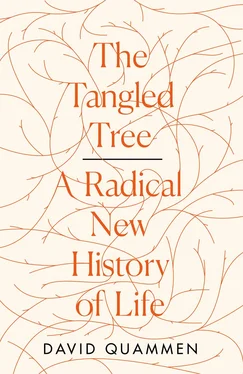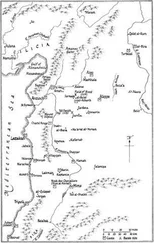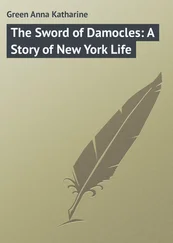The tree of life was better. It was already a venerable notion in 1837, and Darwin could adapt it to his purposes as an evolutionary theorist—easier than inventing a new trope from scratch. Of course, to make that adaptation was to alter its meaning radically. Never mind, he took the step. Ten notebook pages along, he sketched a much livelier and more complex figure in bold strokes, with a trunk rising into four major limbs and several minor ones, each major limb diverging into clusters of branches, one branch within each cluster labeled A, B, C, D. The branches B and C were near neighbors in the treetop, within adjacent clusters, indicating close relationships among the creatures on those branches. The letter A was far away, on the opposite side of the tree’s crown, signaling a more distant relationship—but still a relationship. The letters were placeholders, meant to represent living species, or maybe genera. Felis, Canis, Vulpes, Gorilla. We don’t know exactly what he had in mind, and maybe it was nothing so specific. Anyway, this was a thunderous assertion, abstract but eloquent. You can look at the little sketch today, with its four labeled branches amid the limbs and the crown, and imagine the evolutionary divergence of all life from a common ancestor.

Darwin’s 1837 sketch, redrawn by Patricia J. Wynne.
Just above the sketch, as though gesturing toward it bashfully, Darwin wrote: “I think.”
3

Darwin didn’t invent that phrase, “the tree of life,” nor originate its iconic use, though he put it to new purpose in his theory. Like so many other metaphors embedded deep in our thinking, it came down murkily, modified and reechoed, from early versions in Aristotle and the Bible. (Why do these things always go back to Aristotle? Well, that’s why he’s Aristotle.) In the Bible, it’s a grand bookend motif, invoked in Genesis 3 just as Adam and Eve are booted out of the Garden, and reappearing at the end of Revelation, on the very last page of the King James version—excellent placement for a launch into Western culture. There in Revelation 22, verses 1–2, the authorial prophet describes his ecstatic vision of the “water of life,” flowing out like a pure river from the throne of God, and beside which grows “the tree of life,” bearing fruit every month, plus leaves “for the healing of the nations.” This tree possibly represents Christ, supplying his leafy and fruity blessings to the world; or maybe it’s grace, or the Church. The passage is opaque, and differences in translations (one tree or many?) have confused things further. The point here is simply that the “tree of life” is an ancient poetic image, a resonant phrase, variously construable, with a long presence in Western thought.
In Aristotle’s History of Animals , written during the fourth century BCE, the tree of life is not yet a tree. It’s more like a ladder of nature or—as later Latinized from his Greek—a scala naturae. According to Aristotle, the diversity of the natural world “proceeds” from lifeless thingssuch as earth and fire to living creatures such as animals “little by little,” in a progression so incremental that it’s impossible to draw absolute lines between one form and another. This idea remained useful throughout the Middle Ages and beyond, turning up in woodcuts during the sixteenth century as a Great Chain of Being or a Ladder of Ascent and Descent of the Intellect , which typically rose step-by-step from inanimate substances such as stone or water, to plants and then beasts, then humans, then angels, and finally to God. By that point it was a “Stairway to Heaven,” almost five centuries before Led Zeppelin.
The Swiss naturalist Charles Bonnet reverted to this linear, stair-step model as late as 1745, even while other Enlightenment thinkers and artists were allowing images of nature’s diversity to burgeon sideways with limbs and branches. Bonnet’s treatise on insects, published that year, included a foldout diagram of his “Idea of a Scale of Natural Beings,” arranged in vertical ascent from fire, air, and water, through earth and various minerals, upward to mushrooms, lichens, plants, and then sea anemones, followed by tapeworms and snails and slugs, upward further to fish and then flying fish in particular, and then birds, above which came bats and flying squirrels, then four-legged mammals, monkeys, apes, and lastly man. See the logic? Flying fish are superior to other fish because they fly; bats and squirrels exist on a higher level than birds because bats and squirrels are mammals; orangutans and humans are the best of mammals, and humans are more best than anybody. Bonnet made his living as a lawyer but much preferred studying insects and plants. He was a lifelong citizen of the Republic of Geneva, his French ancestors having been chased out of France by religious persecution, and so maybe it’s no accident that his ladder diagram culminated in people, not God.
The other notable absence from Bonnet’s scale of natural beings, besides God, are microbes. He paid no attention to microorganisms, although the pioneering Dutch microscopist Antoni van Leeuwenhoek had discovered the existence of bacteria, protozoans, and other tiny “animalcules” about seventy years earlier. We all know Leeuwenhoek’s name from our reading in high school of Paul de Kruif’s Microbe Hunters (a terrible book full of concocted dialogue and bogus detail, but an influential doorway to the subject) or other storybook histories of science, though we might not remember that Leeuwenhoek was a draper in Delft who started making his own magnifying lenses in order to better inspect the thread-count of textiles. Then he turned the lenses onto other materials, out of sheer curiosity, and made astonishing discoveries: he found menageries of tiny creatures living in lake water, in rain water, in water from drain pipes, even in scrapings of crud from his own teeth.
Leeuwenhoek’s revelatory observations of microbial life were reported in the journal of the Royal Society of London and became famous in scientific circles throughout Europe, but Charles Bonnet wasn’t interested enough in those “ very wee animals” to fit them into his rising scale—not even where they might dismissively have been slotted, somewhere between asbestos and truffles. That omission presages a lasting discomfort with placing microbes on the ladder of life or, harder still, arranging their diverse forms on the tree—and it’s a discomfort to which I’ll return, because it became acute in 1977.
The linear approach to depicting life’s diversity was on the way out, notwithstanding Charles Bonnet’s scale of nature, and being replaced by its more complicated and dimensional successor, the tree. By the late eighteenth century and the start of the nineteenth, natural philosophers (we’d call them scientists, but that word didn’t yet exist) tried to classify and arrange living creatures into distinct groups and subgroups, reflecting their similarities and differences and some sort of organizing schema. The linear alignment, in order of what passed for increasing sublimity, the ladder raised toward God, was no longer satisfactory. There had been a knowledge explosion in Europe since the great age of sailing explorations began—knowledge of diverse animals, plants, and other creatures from all over the world—and scholars wanted to set that explosive abundance of new facts within hierarchical categories so that it could be easily accessed and used.
Читать дальше














